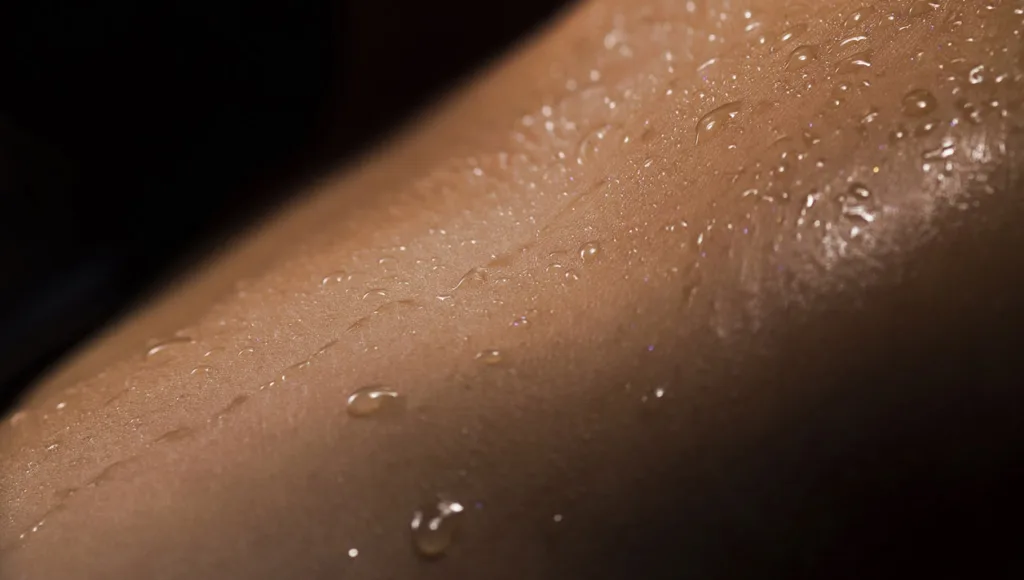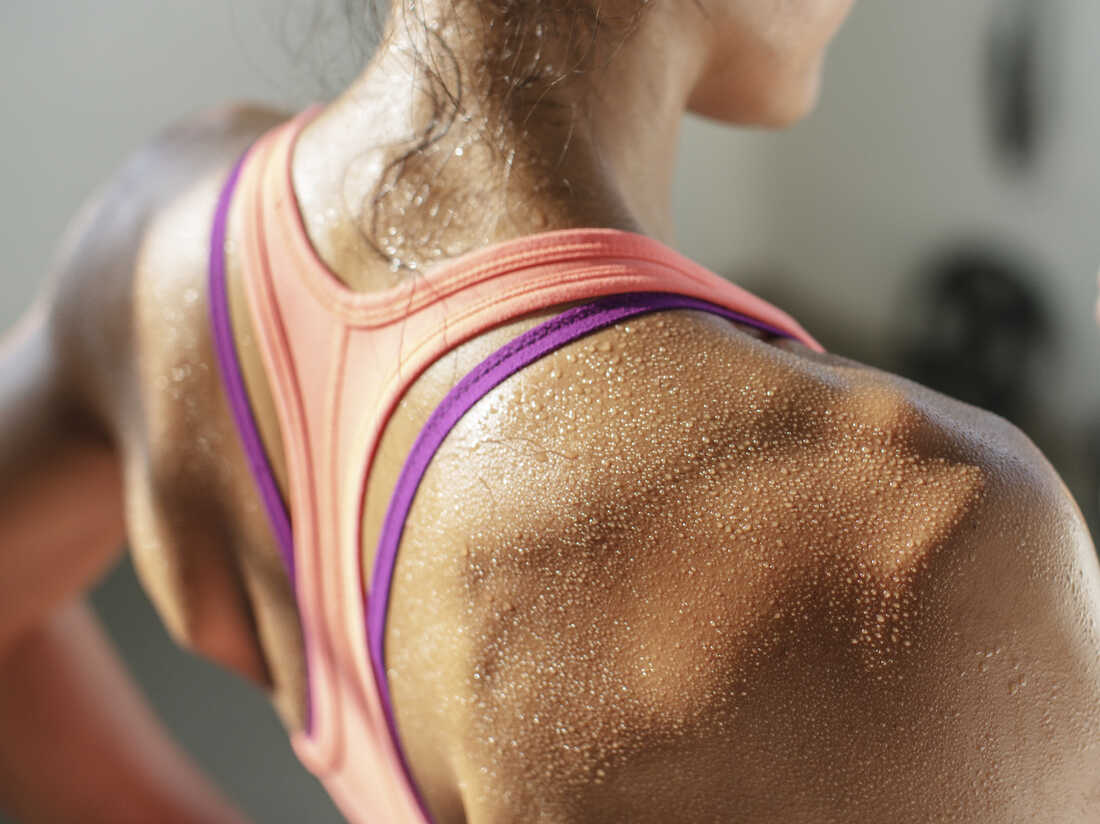Sweating during exercise provides awesome and powerful health and fitness benefits. As we journey towards success in transforming our bodies through physical activity, the science behind sweat reveals some fascinating truths. Contrary to popular belief, sweating isn’t just a superficial bodily function that signifies hard work. It serves important biological purposes with holistic impacts on our overall well-being.
Let’s explore the surprising physiology, weight loss effects, detoxification capacity and mood-enhancing magic behind sweat!

The Physiology of Sweat
Sweat is produced by specialized glands in the skin called eccrine glands. These glands discharge a mixture of water, salts and minerals onto the skin’s surface when the body gets hot. This discharge cools the body as heat gets transferred from the skin into the air via evaporation.
The amount of sweat produced is carefully regulated based on internal body temperature. When receptors in the skin and central nervous system sense a temperature rise, eccrine glands activate and start secreting more fluid. This causes more sweat to accumulate on the skin’s surface, allowing increased heat loss through evaporation.
An interesting chemical in sweat is lactic acid. Produced during intense muscular exertion, lactic acid protects muscle cells from overactivity during exercise. As lactic acid gets removed through sweating, muscle soreness the next day is reduced.
Sweating and Weight Loss
It’s a common misconception that sweating during exercise directly burns a noticeable amount of fat. Sweat is mostly composed of water with traces of urea, salts and minerals – no fat metabolism occurs in eccrine glands. However, sweating does aid in calorie burning since heat is energy. The thermic effect of sweating out up to 1L of water could burn around 80 calories!
Additionally, sweating helps mobilize stored water weight and reduces temporary physical bloating. However it doesn’t reduce levels of subcutaneous or visceral body fat. Actual fat loss occurs due to the increased calorie expenditure facilitated by the acceleration of heart rate, rise in body temperature and extra work done by muscles during exercise.

Detoxification Through Sweat
Toxins get accumulated in bodily fluids and organs over time due to environmental pollutants, preservative-laden foods, alcohol and medications. Sweat is one of the body’s mechanisms for releasing toxins and maintaining health. When mineral salts combine with these toxins in sweat fluid, elimination occurs through the skin’s porous surface.
Studies show toxins like arsenic, lead, zinc, nickel, mercury and cadmium get excreted in measurable concentrations through sweat. Increased sweating volume during physical activity allows enhanced elimination of accumulated toxins. This may prevent toxin overload in organs like the liver and kidneys.
Additionally, sweat contains antimicrobial peptides that combat acne-causing bacteria. Its slight acidity also helps restore skin pH balance and improve complexion. This makes breaking a good sweat during workouts beneficial for skin health and anti-aging.
Endorphins and Mood Enhancement
The magic of sweat lies deeper than the glistening beads trickling down your forehead. During medium to high intensity exercise, endorphins get released in the brain. These feel-good chemicals called neurohormones act as natural pain relievers by bonding to neuron receptors in the body and brain.
Raised endorphin levels increase pain tolerance, heighten focus, enhance mood and induce euphoria. This phenomenon is popularly called “runner’s high”. Combined with a simultaneous rise in body temperature, heightened endorphin levels from sweat-inducing workouts deliver powerful feel-good, mood-altering benefits!
Furthermore, studies show regular endorphin boosts from consistent exercise helps manage anxiety, alleviate depression and enhance confidence. The cumulative stress-reduction, mood-enhancement and mental health benefits of breaking a sweat 3 to 5 times a week makes consistency key.

Maximizing the Benefits of Sweat
Now that you know the science behind sweat and its multifaceted impacts – are you motivated to work up more of a lather during exercise?
Here are some tips to sweat more effectively and safely:
● Warm Up Before Intense Exercise: Cold muscles are more prone to tears and strains. Do light cardio for 5-10 mins to raise muscle temperature before strength training or HIIT. This allows you to sweat faster subsequently.
● Know YourFitness Levels: Don’t overexert beyond your current fitness levels. Progress intensity slowly each week to avoid burnout, fatigue or demotivation. Listen to your body’s cues.
● Hydrate, Hydrate, Hydrate: Drink 16-20 oz of fluid 2 hours before workouts and 6 to 8 oz every 20 minutes during exercise to replenish sweat fluid losses. This maintains performance and promotes continual sweat response.
● Wear Breathable Fabrics: Sweat-wicking compression gear or moisture absorbing cottons optimize airflow for more effective sweat evaporation and cooling.
● After-Shower Skin Care: Post workout showers, gently scrub sweat residue from pores and moisturize skin to avoid acne or rashes.
While high-intensity cardio and metabolic circuits induce copious sweating, any exercise raising your core body temperature contributes to some biological form of cleansing. Even gentle sweat-breaking fat burning zone training on incline treadmills or static bicycling provides therapeutic value.
Finding enjoyable sweat-inducing physical activities and building them into your weekly fitness rhythms magnifies consistency. This pays health dividends over time!
The Surprising Science Behind Sweat: Key Takeaways
Through this exploration of the physiology, weight loss effects, detoxification capacity and mood-altering power behind sweat, one thing is clear – not all sweat is created equal!
Breaking a good sweat during balanced exercise facilitates calorie burn, releases endorphins, eliminates toxins, reduces soreness, boosts skin health and enhances mood naturally. Making it a lifestyle habit with appropriate rest for recovery will transform your body holistically.
Now that you know the science behind sweat, will you embrace it as the fountain of youth you’ve been seeking all along?
Thank you for reading this post, don't forget to subscribe to our free newsletter
!
